Hello everyone! I’ve returned once more to the well of tabletop gaming, this time with a pure deck builder! And it’s based around one of my favorite art forms as well: the theme park! (Yes, theme parks are art, we’ll talk about it some other time). So, without further ado, let’s dive right into Good Games Publishing‘s Unfair and see what we’ve got in store! And if you’d like to check out the slightly more positive successor to Unfair, you can check out Brody’s review of Funfair here.
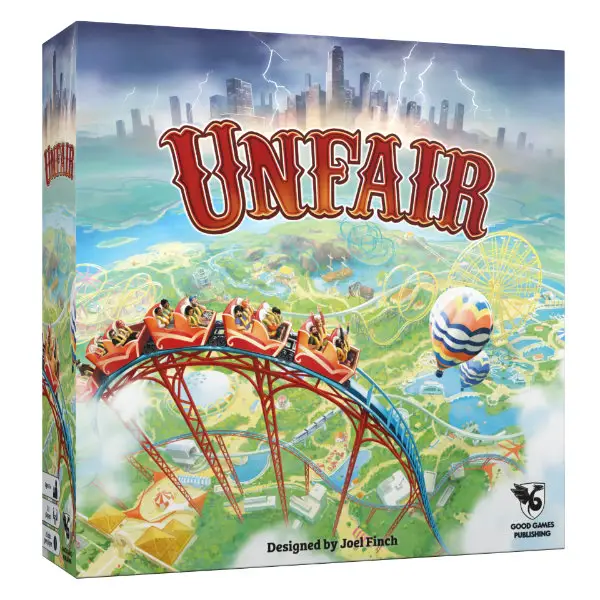
Overview
Unfair is, at its heart, a deck builder. Oh, there’s a board, but much like a game mat for something like Magic: The Gathering or Yu-Gi-Oh, it’s really just there for the organization of the cards, as well as to better mark out the passage of the phases within each of the game’s rounds. There are tokens and there’s dice and they’re important to the game of course. But what matters most are the cards, for they’re what represent your theme park.
The overall goal of the game is to build the city’s greatest theme park (so I guess we’re in Orlando in the 80s) which does mean that, unlike Techlandia, you’re going to need at least two people to play this. The goal is to score the most points at the game’s end, which can be accomplished in three ways-highly upgraded attractions (each attraction and upgrade has a point total attached to it), matching your park to pre-made blueprint cards, and buying with stored up coin tokens.
We’ll talk about gameplay and how it works in a bit, but first, let’s talk about a key part of any game, how it looks!
Presentation
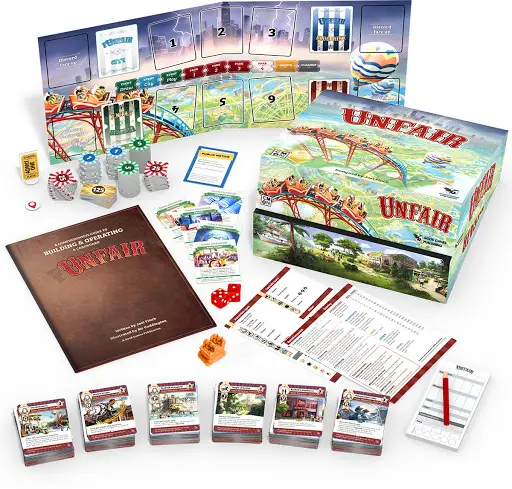
The presentation on Unfair is, fittingly for a game about making a high-end theme park, excellent. The board is, like I said, simplistic, existing just to help lay out the cards, but it’s of good quality with good art. And it’s designed to let you flip it over so that you can use it equally well depending on if everyone’s on the same side of the table or opposite of each other (I used the former, but for more than two players the latter would likely be more useful).
Everything is made of quality material, from the dice to the tokens to the cards. Even the eraser on the pencil the game provides for the disposable score tracking cards is good (though the game does have a free scoring app, so your mileage may vary on if that’s actually useful or not).
And the art is, well, excellent. The unique art for special, themed attractions is lovely, and the repeated art is also good. I know I harped a bit on Techlandia for its repeated art, but that was different. I’m not going to get upset that they didn’t try and come up with ten different ways to draw an air conditioning unit. The art is good looking and it’s varied, each type of upgrade and staff member has its own art, and that’s good enough for me.
Now when it comes to the instruction manual…that’s a bit of a mixed bag. On the one hand, the art is good, and there’s some fun little bit designed to look like the writer went in and crossed stuff out and wrote in new things to represent the updates. It has personality. But I won’t lie, I found the first setup stressful. Looking back at it I couldn’t tell you why, exactly, it was so stressful, but it was. The instructions are not clear and the cards just aren’t packaged great. Let me explain in the next section.
Setup
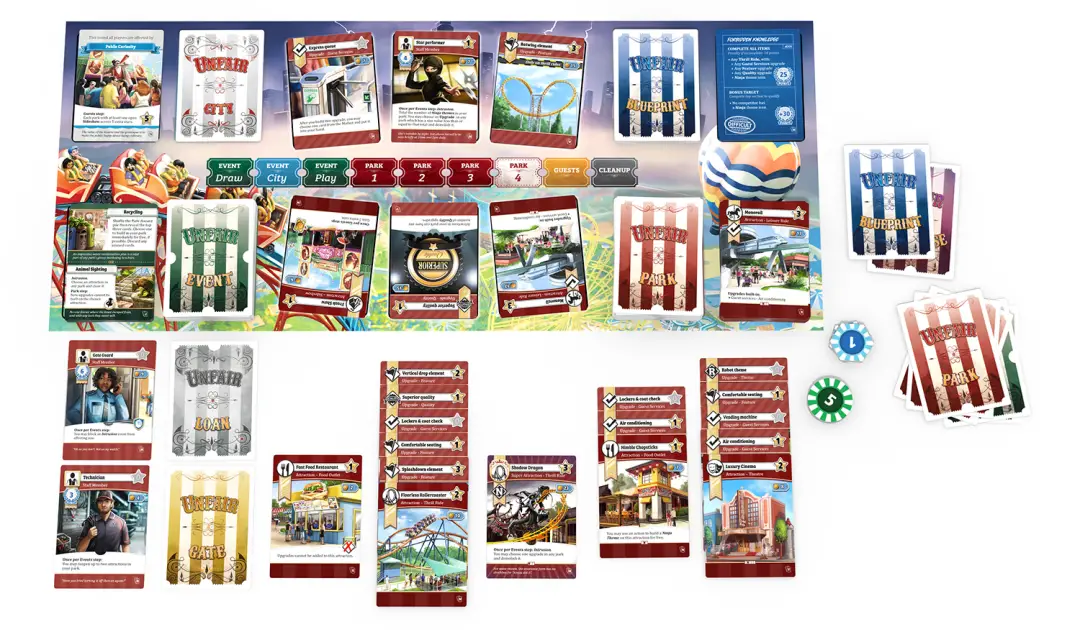
Unfair has six types of cards in the base game, each themed around a different aesthetic. They are Gangster, Jungle, Ninja, Pirate, Robot, and Vampire. Each themed deck has fifty-seven cards each…twenty-four of which are not actually unique to their themes. You will, instead, need to dig through each deck to separate the cards into their different categories-Event, City, Blueprint, Park, and Showcase. You’ll also need to keep four individual cards (Theme Overview, Gate, Loan, and Round & Scoring summary) separate from the rest, as each player will need the latter three, and Theme Overviews are good to have on the side.
Every card type has a unique back and a specially designated place on the board to put them for use during gameplay. But while some Event, City, and Blueprint cards are unique to themes…the majority of them aren’t. So I must confess I don’t know why they’re not packaged together, or why you’re told to separate them by theme when putting the game away (each card has a little mark in the bottom right corner to indicate which theme they belong to).
But, I will concede that once I figured out what on earth I was doing, the setup was pretty easy the second go around. The board is clearly marked out and labeled, and each card type is likewise clearly labeled on the back. You’ll want to be careful while shuffling and pay extra attention to the instructions, but it shouldn’t give you trouble more than once.
The game also has some advice for first-time players, to aid in setup. Specifically, they’re done to help streamline and simplify things, giving, for example, instructions on which particular themes to play with. Robot and Pirate are very simple themes, while Vampire and Gangster are more complicated themes with special mechanics unique to them (the dice are only used when using the Gangster deck), and the Ninja and Jungle themes are somewhere in between.
There are also five Game Changer cards, special cards to be used during setup to change the rules of the game overall. The most basic of these is the ‘First Date’ card, which removes two ‘Unfair City Cards’ from the City Card deck to reduce the game to six rounds, and removes all Showcase and Blueprint cards marked as ‘difficult’ or ‘insane’. The others are likewise drastic, good for mixing up gameplay in different ways. They’re only meant to be used in setup, and cannot be used once gameplay has started.
Gameplay
What we have here is a deck builder crossed with Roller Coaster Tycoon. Once setup is complete, each player should get five Park cards from the deck of them. If you don’t get any attraction cards (which are clearly labeled) then you’re allowed to show your hand, shuffle it back into the deck, and draw five new ones, repeating the process until you have at least one attraction. Each player likewise will likewise get two Showcase cards, to keep face down until they’re used (you can look at your own, but you shouldn’t show anybody else them). Showcases are super attractions. You can only have one per park, and they cost quite a lot to build, but they give you a bonus each round and grant you quite a bit in the way of points to boot.
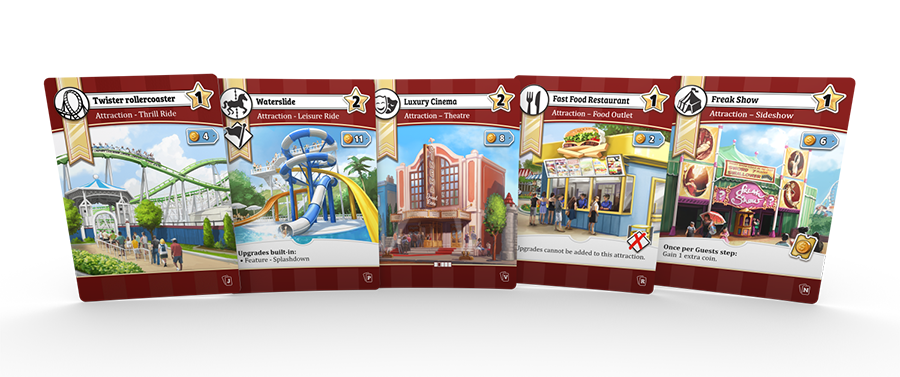
Each player will also start with a Gate card and a Loan card, as well as coin tokens totaling up to twenty (three fives and five ones). The Gate card allows you to build up to five attractions, gives you one star (used for guest totaling), and a guest capacity of fifteen. The Loan card lets you gain extra coins (ten at a time, for a total of forty) at the cost of points at the end of the game. Loans can’t be repaid during gameplay, nor with leftover coins, only with points.
In total there are eight rounds for the game, split into four steps. At the start of each round you flip over a City card from the deck of eight City cards you selected from the thirty-six total in the game. There are four ‘Funfair’ City cards and four ‘Unfair’ City cards on the board. The ‘Funfair’ Cards should be on top of the ‘Unfair’ ones and will give positive or neutral bonuses to the players. ‘Unfair’ cards, on the other hand, will destroy upgrades to your attractions, and sometimes even attractions themselves.
I’m…not a fan of this mechanic. I understand that challenge is necessary for a game, otherwise, you’ve just got Candyland with more steps (and even Candyland has the black dot cards) but the other players can already sabotage you. Every round begins with players drawing Event cards, and most, if not all of them offer opportunities to sabotage the other players. The fact that on top of that, the last four rounds of the game also sabotage you feels excessive. There’s a reason there’s an official variation of this game called Funfair that does away with that mechanic.
At any rate, the rounds are divided into four steps: Events, Park, Guests, and Cleanup.
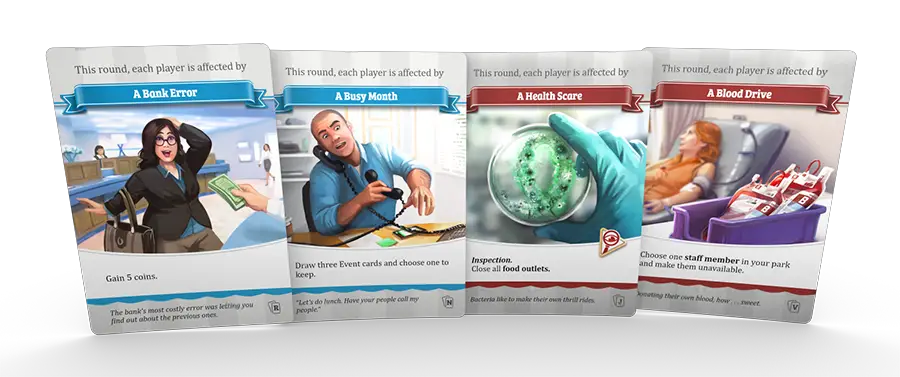
Events step works fairly simply. First, every player draws a card from the Event deck in turn order, than the player who’s first in turn order flips over the top card from the City deck. All players then have to follow the City card’s instructions during their turn, as it remains active the whole round. Once the City card’s instructions have been carried out, each player has a chance to play their Event card, which can be used to either benefit them or sabotage someone else. You can pass and choose not to play your card immediately, but if everyone else passes then you’ll miss out.
Once the Events step is done, it’s time for the Park step. Like Events, the Park step is fairly simple. Every player has three actions per round (though some cards allow one or more players to take a fourth action), moving in turn to work on their park. There are four choices for what your action will be-Take, Build, Demolish, or Loose Change.
If you choose to Take then you can pick a face up card from the Market (six face up Park cards), two cards from the Park, Events, or Blueprint decks, from which you can keep one or none, or you can discard one card from your hand to draw five from the Park deck, keeping one and discarding the other four you drew (you can only draw from the Blueprint deck in the first four rounds, however). Build and Demolish are simple, allowing you to place or remove Park cards. And Loose Change allows you to gain one coin for each attraction in your park.
Once you’ve finished the Park step, it’s then time for the Guest step. This is when you take your main income, by counting up the number of guests who visited your park this round. You get one coin per guest, with the number of guests being taken from the stars on the cards. In addition, some cards give bonuses to the number of coins, beyond the price of admission.
And then, finally, it’s time for Cleanup. This is a fairly simple step, where you discard certain cards, reopen any closed attractions or unavailable cards (can happen as a result of the Unfair or Event cards), enact any Cleanup step card abilities, refill the Market, and reduce your hand to five cards if you went over.
These Steps repeat until all the rounds are finished and then points are tallied up, based upon the size of Attractions, completed Blueprints, coins earned, and bonuses from Staff member cards. Whoever has the most points wins.
Expansion Pack
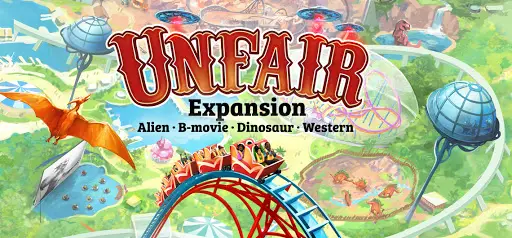
Now, before giving some final thoughts, let us discuss the Expansion Pack for Unfair. This pack brings four new theme packs into the game-Alien, B-movie, Dinosaur, and Western. Each brings with it something new. Western is the simplest of the bunch, really only offering the option to place a Vacant Lot card, allowing you to have six attractions, two of which can be super attractions.
In contrast, the other three are…involved. Alien is not about an Alien inspired area so much as an area actually being aided by aliens. This results in a new marker ‘Alien Influence’, the chance for your staff members to be abducted, and some ‘wild card’ type cards’. B-movie focuses on building panoramas (having three to five cards that fit in with each other next to each other to complete a full picture) thus requiring slow and careful planning of your park. And Dinosaur…goes full Jurassic Park, complete with the chance every turn for the actual dinosaurs to escape and go on a rampage, though there are things you can do to mitigate this risk.
All in all the Expansion Pack is well crafted, with more lovely art and plenty of care and attention to detail, just like the base game. However, it is not a casual experience. The instruction manual notably recommends that newcomers only touch the Western deck. If you’re only a casual fan of Unfair, I can’t really recommend it, as the other three decks all add a lot more depth and complexity. Which is not a bad thing of course! But it’s something to be mindful of when purchasing.
Final Thoughts
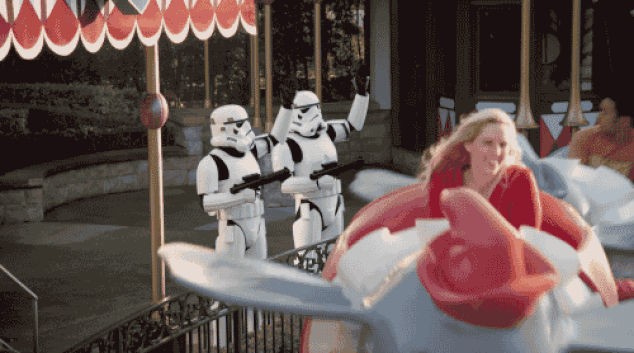
All in all, I rather enjoyed Unfair. It has undeniable problems-difficult first time setup, and unnecessary difficulty spike for the last half of the game, but it was still a fun experience, especially the second time around. It’s got good art, good design, and is well crafted. For all its flaws I really do like it, and I look forward to playing it in the future.
[rwp_box_criteria id=”0″]
You can pick up a copy of Unfair from Amazon or at your FLGS!
Images Courtesy of Good Games Publishing
Have strong thoughts about this piece you need to share? Or maybe there’s something else on your mind you’re wanting to talk about with fellow Fandomentals? Head on over to our Community server to join in the conversation!

